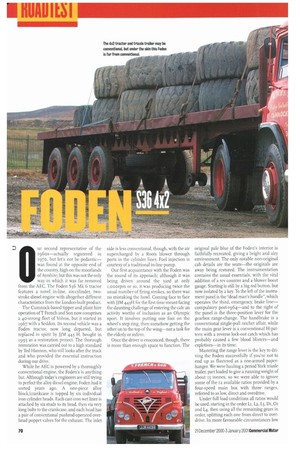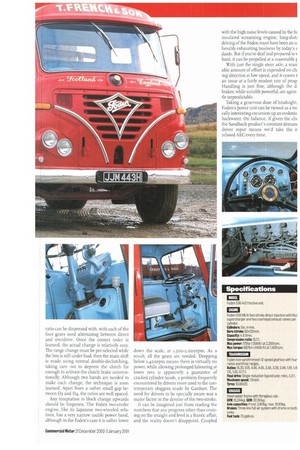D ur second representative of the
Page 72

Page 73

If you've noticed an error in this article please click here to report it so we can fix it.
19605—actually registered in 1970, but let's not be pedantic— was found at the opposite end of the country, high on the moorlands of Ayrshire; but this was not the only way in which it was far removed from the AEC. The Foden S36 Mk 6 tractor features a novel in-line, six-cylinder, twostroke diesel engine with altogether different characteristics from the London-built product.
The Cumnock-based tipper and plant hire operation of T French and Son now comprises a 40-strong fleet of Volvos. but it started in 1967 with a Seddon. Its second vehicle was a Foden tractor, now long departed, but replaced in spirit by IJM 443 H, bought in 1993 as a restoration project. The thorough restoration was carried out to a high standard by Ted Hannon, who still looks after the truck and who provided the essential instruction during our drive.
While he AEC is powered by a thoroughly conventional engine, the Foden's is anything but. Although today's engineers are still trying to perfect the alloy diesel engine. Foden had it sorted years ago. A one-piece alloy block/crankcase is topped by six individual iron cylinder heads. Each cast-iron wet liner is attached by six studs to its head, then via very long bolts to the crankcase, and each head has a pair of conventional pushrod-operated overhead poppet valves for the exhaust. The inlet side is less conventional, though, with the air supercharged by a Roots blower through ports in the cylinder liner. Fuel injection is courtesy of a traditional in-line pump.
Our first acquaintance with the Foden was the sound of its approach; although it was being driven around the yard at only L000rpm or so. it was producing twice the usual number of firing strokes, so there was no mistaking the howl. Coming face to face with JIM 4431-I for the first time meant facing the daunting challenge of entering the cab: an activity worthy of inclusion as an Olympic sport. It involves putting one foot on the wheel's step ring, then somehow getting the other on to the top of the wing—not a task for the elderly or infirm.
Once the driver is ensconced, though, there is more than enough space to function. The original pale blue of the Foden's interior is faithfully recreated, giving a bright and airy environment. The only notable non-original cab details are the seats—the originals are away being restored. The instrumentation contains the usual essentials, with the vital addition of a rev counter and a blower boost gauge. Starting is still by a big red button, but now isolated by a key. To the left of the instrument panel is the "dead man's handle", which operates the third, emergency, brake line— compulsory post-1964--and to the right of the panel is the three-position lever for the gearbox range-change. The handbrake is a conventional single-pull ratchet affair, while the main gear lever is a conventional H-pattern with a reverse lock-out catch which has probably caused a few blood blisters—and expletives in its time.
Mastering the range lever is the key to driving the Foden successfully if you're not to end up as flustered as a one-armed paperhanger. We were hauling a period York triaxle trailer, part loaded to give a running weight of about 13 tonnes, so we were able to ignore some of the rz available ratios provided by a four-speed main box with three ranges, referred to as Vow, direct and overdrive.
Under full load conditions all ratios would be used, starting in the order Li, L2, L3, DI, Di and 14, then using all the remaining gears in order, splitting each one from direct to overdrive. In more favourable circumstances low
ratio can be dispensed with, with each of the four gears used alternating between direct and overdrive. Once the correct order is learned, the actual change is relatively easy. The range change must be pre-selected while the box is still under load, then the main shift is made using normal double-declutching, taking care not to depress the clutch far enough to activate the clutch brake unintentionally. Although two hands are needed to make each change, the technique is soon learned. Apart from a rather small gap between 03 and 04, the ratios are well spaced.
Any temptation to block change upwards should be forgotten. The Foden two-stroke engine, like its Japanese two-wheeled relatives, has a very narrow usable power band, although in the Foden's case it is rather lower down the scale, at 1,5 oo-2,000rpm, As a result, all the gears are needed. Dropping below 1,400rpm means there is virtually no power, while allowing prolonged labouring at lower revs is apparently a guarantee of cracked cylinder heads, a problem frequently encountered by drivers more used to the contemporary sloggers made by Gardner. The need for drivers to be specially aware was a major factor in the demise of the two-stroke.
It can be imagined just from reading the numbers that any progress other than cruising on the straight and level is a frantic affair, and the reality doesn't disappoint. Coupled
with the high noise levels caused by the ix insulated screaming engine, long.distt driving of the Foden must have been an u: lievably exhausting business by today's s dards. But if you're deaf and prepared to v hard, it can be propelled at a reasonable r
With just the single steer axle, a man able amount of effort is expended on eh ing direction at low speed, and it ceases t an issue at a fairly modest rate of progi Handling is just fine, although the d brakes, while suitably powerful, are again de unpredictable.
Taking a generous dose of hindsight, Foden's power unit can be viewed as a tec cally interesting excursion up an evolutio backwater. On balance, if given the cht the Sandbach product's constant demant driver input means we'd take the n relaxed AEC every time.








































































































































